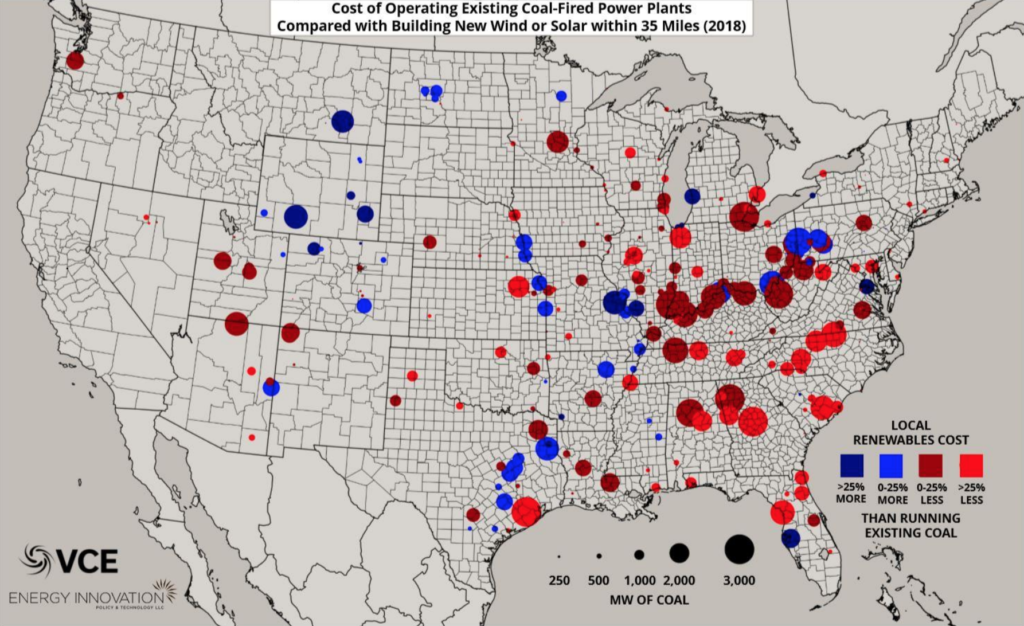According to a new study around 75% of US coal production is now more expensive in providing electricity than renewables. The Coal Cost Crossover Report is an in-depth study using data from the Energy Information Administration to calculate the cost of electricity production with renewables such as solar and wind compared to coal plants. Findings not only show that two thirds of US coal plants are currently out-competed, but that by 2025 the entirety of electricity produced from coal will be more expensive than with renewables.
“Even without a major policy shift we will continue to see coal retire pretty rapidly,” claims Mike O’Boyle, the co-author of the report, when talking to The Guardian. Coal is becoming ever more expensive when compared to renewables because of both the rising costs of coal production (influenced by carbon taxes and requirements to control emissions), and the fact that solar and wind power is becoming ever-cheaper as technology improves. A recent Bloomberg report, highlights that the cost of electricity for lithium-ion batteries has fallen 35% since the first half of 2018 and likewise offshore wind costs have tumbled by 24%. In fact, even without subsidies, solar and wind energy are now competing with coal for the provision of “dispatchable power”, which refers to constant provision of electricity (whenever the grid needs it) and not just when it’s a windy or sunny day. The EIA’s January 2019 reports also confirm this trend, highlighting that since 2008 over half of US coal mines have shut down and renewable electricity generation has doubled.
The social cost of transitioning
However, transitioning from coal to renewables also represents a social challenge as labour markets are forced to adapt. An excellent case in point is the effects of decommissioned Navajo Nation coal plants in the USA. The Navajo Nation has relied heavily on the employment generated by coal plants for decades; an industry that has generated over $150 million in annual taxes and wages, as well as thousands of local jobs. Now, two of the four major coal plants in the area are scheduled to close by 2025, with the fate of the third and fourth ones also likely to be sealed by 2025 and 2035 respectively. Tribal officials predict $35 million in budget cuts in 2021 as a result of the closures. Although, studies indicate that the potential for renewables across Navajo country is huge, it remains unclear as to how many jobs and how much revenue for local communities wind and solar will create. Planning for the transition at a local level is lagging dangerously behind.
 “There is a difference between closure and transition,’’ says Amanda Ormond, a consultant and former director of the Arizona Energy Office when speaking for Scientific American. “This will be a cautionary tale of how not to close coal plants. There hasn’t been the time. There hasn’t been sufficient focus on the nation of what can come next. There are a variety of factors that could lead to not an ideal closure. We have to have a state-wide dialogue.”
“There is a difference between closure and transition,’’ says Amanda Ormond, a consultant and former director of the Arizona Energy Office when speaking for Scientific American. “This will be a cautionary tale of how not to close coal plants. There hasn’t been the time. There hasn’t been sufficient focus on the nation of what can come next. There are a variety of factors that could lead to not an ideal closure. We have to have a state-wide dialogue.”
Research such as the Coal Cost Crossover report is telling us that the best way to combat climate change is to turn to technology so that we can accomplish our goals with less environmental impacts. Renewable energy is a key part of this transition and, now that it is becoming more cost effective than fossil fuel alternatives such as coal, important case studies are highlighting the need to focus on an effective transition, so as that no one is left behind. In fact, the Navajo case is just one of countless others that demonstrate the social consequences of transitioning without adequate planning. We have reached the carbon cost crossover, but the transition to renewables will require careful social engineering.
Read the Coal Cost Crossover Report.







